The Best Milk Chocolate Bars
Gourmet Milk Chocolate That Will Please Even Dark Chocolate Lovers
CAPSULE REPORT: July 28th is National Milk Chocolate Day. To celebrate the holiday, we asked our chocolate specialist, Peter Rot—who has sampled most of the top (and less-than-top) milk chocolate bars made—to give us his recommendation of the best gourmet milk chocolate. Two of the brands, Bonnat and Santander, are kosher.
Chocolate Bar History
The first chocolate bar was created in 1847 (and it was not a milk chocolate bar!). Prior to then, chocolate was consumed largely as the Spanish conquistadors had received it from the Aztecs—as a beverage, although Europeans had sweetened it and spiced it in different ways to make the bitter chocolate drink more palatable, even inventing the molinillo to add more froth.
It took 300 years for the great-grandson of the founder of Joseph Fry & Co., in Bristol, England, to figure out how to mix some of the cocoa butter back into the “Dutched” cocoa powder, add sugar and mold the paste into the world’s first chocolate bar (which was called “chocolate for eating,” to distinguish it from “drinking chocolate”).
That bar was rough and gritty, not the smooth, velvety bar we enjoy today—but it was a welcome addition nevertheless.
Two landmark chocolate events occurred in 1879 in Switzerland:
- Rodolphe Lindt invented the conching machine, enabling the production of the smooth, velvety chocolate we know today.
- Daniel Peter, a chocolate manufacturer, made the first milk chocolate, by substituting powdered milk for the whole milk or cream that had been used previously, with unsuccessful results.
- Powdered milk had been invented by his neighbor, Swiss chemist Henri Nestlé.
- So while the Spanish were responsible for bringing cacao to Europe from the New World and Englishman Joseph Fry created the first chocolate bar, the Swiss have full ownership of smooth, silky milk chocolate.
A Kiddie Treat
With a taste more of sugar and milk than cacao, milk chocolate was first made for children. The typical milk chocolate on the market today consists of no more than 33% cacao (cocoa solids), but many companies drop that percentage even lower, sometimes to the teens, since sugar is cheaper than cocoa.*
That means that the remaining portion of the bar is comprised of milk solids and sugar, and that’s why inexpensive chocolate bars taste like no more than sugar: They are!
By law, the FDA enables manufacturers to use as little as 10% cacao (also known as cocoa solids or cocoa liquor), no less than 3.39% milk fat, and no less than 12% of total milk solids.
The remaining ingredient is sugar, so an inexpensive chocolate bar can be about 75% sugar. (The formula, or “recipe,” is up to the manufacturer, as long as the percentages do not drop below the FDA’s minimal requirements.)
Yet, to our chagrin, most U.S. children are brought up on this cheap milk chocolate, and learn to love what they think is “milk chocolate” (and we would claim is cocoa-flavored sugar-milk bars).
Like eating jelly beans, which are virtually flavored sugar, low-end milk chocolate “satisfies a sweet tooth,” or maybe satisfies a childhood desire—but a non-discriminating palate—for a piece of chocolate.
Today, no one need eat bad milk chocolate. The greatest chocolate producers in the world make milk chocolate bars that are as good as it gets.
Using the best cacao beans, the most meticulous processing techniques and the finest recipes, they create eye-opening milk chocolate that has nothing to do with the chocolate bars of youth (unless your youth was spent with extremely discriminating parents).
This chocolate is so good that those chocolate lovers who ran from cloying, characterless milk chocolate long ago will return to the fold. You’ll read more about our favorite milk chocolate bars below.
__________________
*Another reason for cheap milk chocolate is that a high ratio of milk and sugar mask any irregularities and bad tastes that poor cacao beans often possess. Thus, manufacturers can buy the cheapest, lowest-grade beans (which are still more expensive than sugar and milk solids) and hide their off-flavor with blankets of milky sweetness. So in the end, one is not getting a “chocolate experience,” but a mere whisper of one.
_____________________________
Milk Chocolate Versus Dark Chocolate
Reports of scientific research on the health benefits of antioxidants—and the high antioxidant level of cacao, from which chocolate is made—have fanned the flames of media and marketing people over the last few years.
“The health benefits of dark chocolate” have been touted widely, citing its ability to increase blood circulation, lower cholesterol.
Milk chocolate, which used to represent up to 70% of sales in the U.S., saw a deep flip-flop as consumers went from purchasing mass market to purchasing the most expensive, higher-percentage chocolates in the name of “health.”
To cut through the hype: “Chocolate” is not good for your health. It brings sugar, fat and 2,300 calories per pound. It should be considered a sweet treat and eaten in moderation.
“Cacao,” or cocoa powder ground from the roasted bean before sugar and fat have been added, is a good source; lab tests that measure antioxidants are done on high-quality, undutched cocoa powder.
Down the road, we may possibly find that the best way to intake chocolate antioxidants in a way that makes caloric sense is through a special cocoa beverage with lowfat milk.
But we’re not there yet, and antioxidants are better found in other foods—Montmorency cherries, which can be enjoyed in a delicious juice with calories analogous to orange juice, have the highest ORAC rating (a test that measures antioxidant levels). Speak with a nutritionist to plan a good “antioxidant eating” program.
Dark Milk Chocolate
Traditionally, most milk chocolate bars were made to be sweet—just 30 to 33% cacao.
As chocolate connoisseurship has grown over the past decade, fine chocolatiers began to introduce higher cacao content into their milk bars, and bars with 40% or more cacao became known as “dark” milk chocolate—the bars look darker and taste much more chocolaty, while maintaining their milky quality.
Valrhona introduced Jivara, a 40% cacao milk bar; Slitti developed the Lattenero line with milk bars of (“milk-dark”) in 45%, 51%, 62% and 70% cacao.
The 70% bar looks as dark as any 70% bittersweet bar, but contains milk and has the milky flavor and smoothness, without the sugary sweetness. Bonnat followed with a trio of 65% origin cacao bars.
Today, many people consider cacao contents of 36% or more as dark milk chocolate. It’s not the percentage sign on the label as much as the intensity of cacao flavor that the company has managed to achieve in its production process. As you’ll read below, the Plantations 38% bar tastes like a 50% cacao bar.
The Best Milk Chocolate Bars
Most of the bars presented below utilize a higher ratio of cocoa solids, which means that you’ll taste more of the cacao than the milk and sugar. In a good milk bar, the latter two ingredients will dampen the intensity of the cacao but will never steal the show—the cacao still remains a driving force in the bar’s final flavor.
Approach these as you would dark chocolate: Take note of the complex flavors and how the ingredients mingle and merge together. (For reference, see our chart of chocolate flavors.) Here we present Bonnat from France, Hachez from Germany, Michel Cluizel from France, Plantations from the U.S., Santander from Colombia and Slitti from Italy. Of particular note:
- The Best Milk Chocolate Bars Ever Made (In Our Opinion): Plantations 38% and Michel Cluizel Mangaro Lait 45%.
- Single Origin Dark Milk Chocolate Bars: Bonnat and Michel Cluizel— opportunities to compare single origin milk chocolate.
- Kosher Dark Milk Chocolate Bars: Bonnat and Santander brands.
Bonnat Asfarth 65%. Without a doubt, Asfarth is the strongest of the Bonnat’s three dark milk chocolate bars; but at the same time comes off as somewhat warlike, as its forceful tobacco notes clash with the milder milkiness in a striking contrast. This creates a love-it-or-hate-it bar: Try it and see which side you’re on.
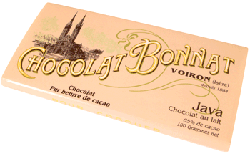 Bonnat Java 65%. Probably the better balanced of the three Bonnats, Java has a cheerful personality—think of it as lemon chocolate mousse. The texture certainly suggests that as well, as it melts like solidified cream and in the meantime leaves a mile-wide smile when the chocolate is gone. Bonnat Java 65%. Probably the better balanced of the three Bonnats, Java has a cheerful personality—think of it as lemon chocolate mousse. The texture certainly suggests that as well, as it melts like solidified cream and in the meantime leaves a mile-wide smile when the chocolate is gone.
Bonnat Surabaya 65%. Surabaya is exceptionally mild and the most milky of the trio, and it might not even satisfy anything beyond a sweet tooth. But we include it among the “best bars” because its worth trying with its siblings to understand how cacao sourced from different parts of a single country can differ in flavor.
Hachez Cocoa de Maracaibo 55.5%. Hachez is notorious for watered-down flavor in its dark chocolate bars, but the company has finally succeeded in creating a palatable bar with beans from the Maracaibo region. The chocolate is extraordinarily nutty and has supportive splashes of red fruits to create an all-around strong chocolate.
Michel Cluizel Mangaro Lait 50%. Next to the Plantations bar (see below), this one has got to be the best milk chocolate ever created. The overall profile is superbly balanced and demonstrates a delicate evolution usually expressed most coherently in dark chocolate. Indeed, even the stoutest of dark chocolate devotees can take comfort with this bar and can even feel safe amongst discriminating peers. One taste will change all preconceived notions of milk chocolate. Limes, strawberries, and nuts make for a decidedly feminine flavor, but the chocolatiness confirms a rigid masculine backbone.
Michel Cluizel Maralumi Lait 47%. Cluizel’s wild and vibrant Maralumi 64% dark 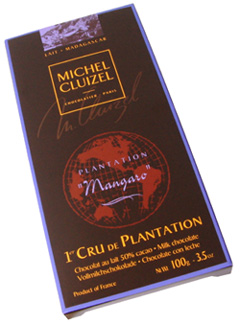 chocolate gets the milk treatment and makes for an interesting 47% milk chocolate bar. The overall tone is decidedly pink, while blueberries, bananas, and dates add a wonderful but very subtle character to the profile. As a whole, however, the chocolate is very light and fairly milky, but still successful nonetheless. This would appeal mainly to those who are still hesitant about trying this class of milk chocolate. chocolate gets the milk treatment and makes for an interesting 47% milk chocolate bar. The overall tone is decidedly pink, while blueberries, bananas, and dates add a wonderful but very subtle character to the profile. As a whole, however, the chocolate is very light and fairly milky, but still successful nonetheless. This would appeal mainly to those who are still hesitant about trying this class of milk chocolate.
Michel Cluizel Grand Lait 45%. This one is the least complex of Cluizel’s milk bars, but by no means is it weak. The chocolatiness is strong enough to subdue the milkiness for the most part, and the profile is very uniform and unchallenging for those who want to test the waters of higher- percentage milk chocolates. But for veterans, this is a charming bar and might even become a regular in your stash.
Plantations 38%. With such a strong chocolaty flavor, one would think the cocoa solids were at least 50%. Somehow, Plantations has created an awesome milk chocolate bar, with a flavor that can only be enjoyed if you’re willing to overlook the abysmal texture. Coffee, nuts, and spice are the dominant flavors, while the sugar and milk never seem to dilute the intensity of the cacao. Each bite will leave you 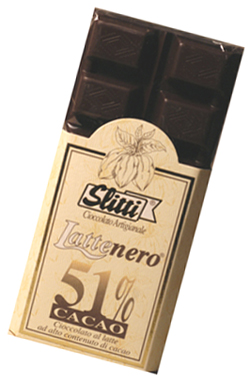 wondering, “How’d they do that?” wondering, “How’d they do that?”
Santander 36%. Although a tad on the sweet side, the cacao stands up valiantly and can be tasted as clear as the sky is blue. The characteristic Santander marshmallow flavor is ubiquitous, but so are the sumptuous strawberry and floral notes and the underlying nuttiness, all of which make this a charming and delightful milk chocolate.
Slitti Lattenero 51%. Slitti has found a good balance between the milk and the cacao, and delivers a bar that is remarkably easy to eat yet very satisfying to the most demanding connoisseur. This bar is quite intensely chocolaty—surprisingly more so than some might assume—and the bar as a whole actually does not emphasize the milk as a direct flavor. Do try the rest of the Lattenero line as well: It’s exciting.
These dark chocolate bars will be eye-opening to people who have only had low-cacao milk chocolate, and to dark chocolate lovers who typically pass milk chocolate by. We can promise both groups: You will find some new favorites here, and you will never look at milk chocolate the same way again.
THE BEST MILK CHOCOLATE BARS
Assorted Bars
- Bonnat
- Hachez
- Michel Cluizel
- Santander
- Slitti Lattenero
Purchase online at Chocosphere.com
Most bars are available nationwide at stores that sell good chocolate bars.
Prices and flavor availability are verified at publication but are subject to change. |
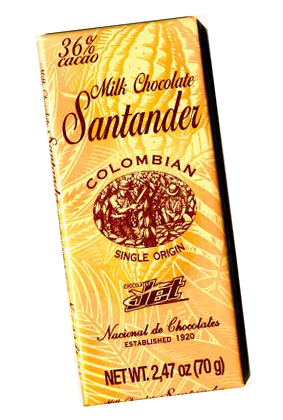
|
Lifestyle Direct, Inc. All rights reserved. Images are the copyright of their respective owners.

|




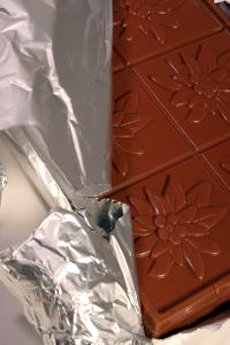
 Bonnat Java 65%. Probably the better balanced of the three Bonnats, Java has a cheerful personality—think of it as lemon chocolate mousse. The texture certainly suggests that as well, as it melts like solidified cream and in the meantime leaves a mile-wide smile when the chocolate is gone.
Bonnat Java 65%. Probably the better balanced of the three Bonnats, Java has a cheerful personality—think of it as lemon chocolate mousse. The texture certainly suggests that as well, as it melts like solidified cream and in the meantime leaves a mile-wide smile when the chocolate is gone. chocolate gets the milk treatment and makes for an interesting 47% milk chocolate bar. The overall tone is decidedly pink, while blueberries, bananas, and dates add a wonderful but very subtle character to the profile. As a whole, however, the chocolate is very light and fairly milky, but still successful nonetheless. This would appeal mainly to those who are still hesitant about trying this class of milk chocolate.
chocolate gets the milk treatment and makes for an interesting 47% milk chocolate bar. The overall tone is decidedly pink, while blueberries, bananas, and dates add a wonderful but very subtle character to the profile. As a whole, however, the chocolate is very light and fairly milky, but still successful nonetheless. This would appeal mainly to those who are still hesitant about trying this class of milk chocolate.  wondering, “How’d they do that?”
wondering, “How’d they do that?”